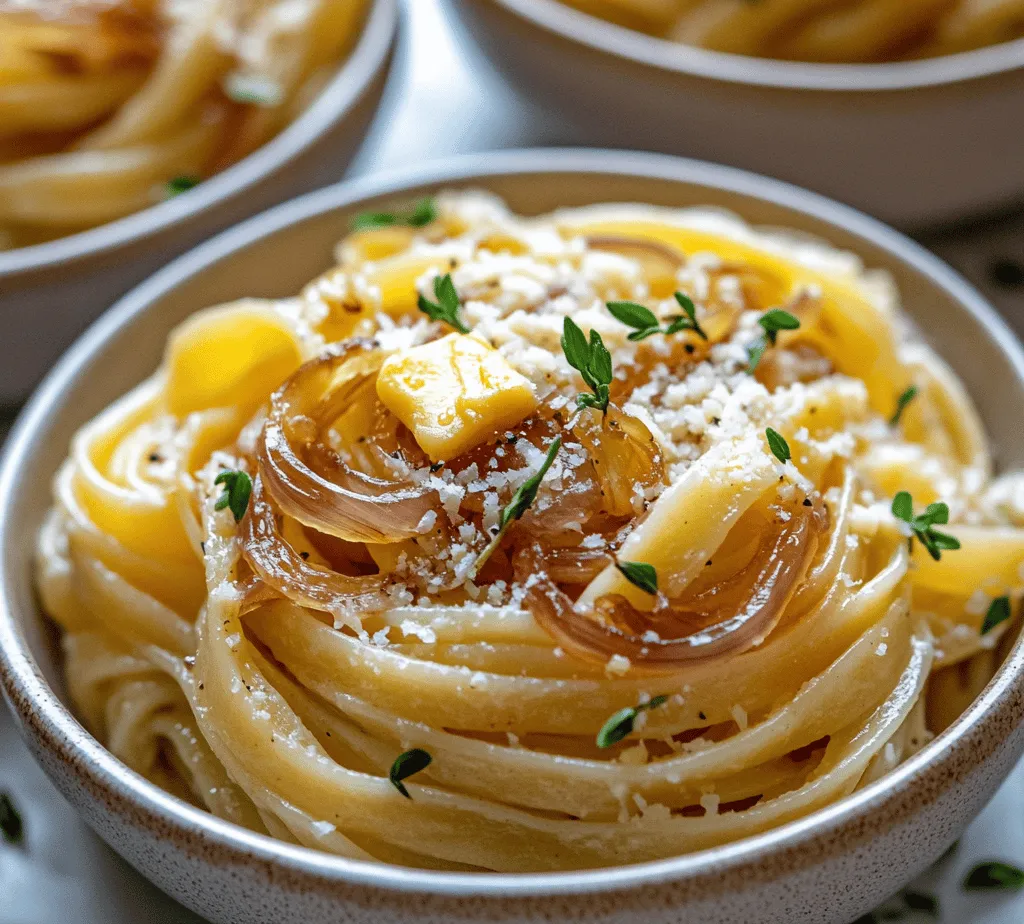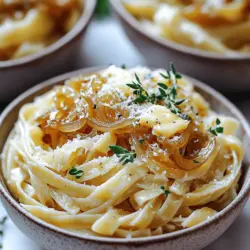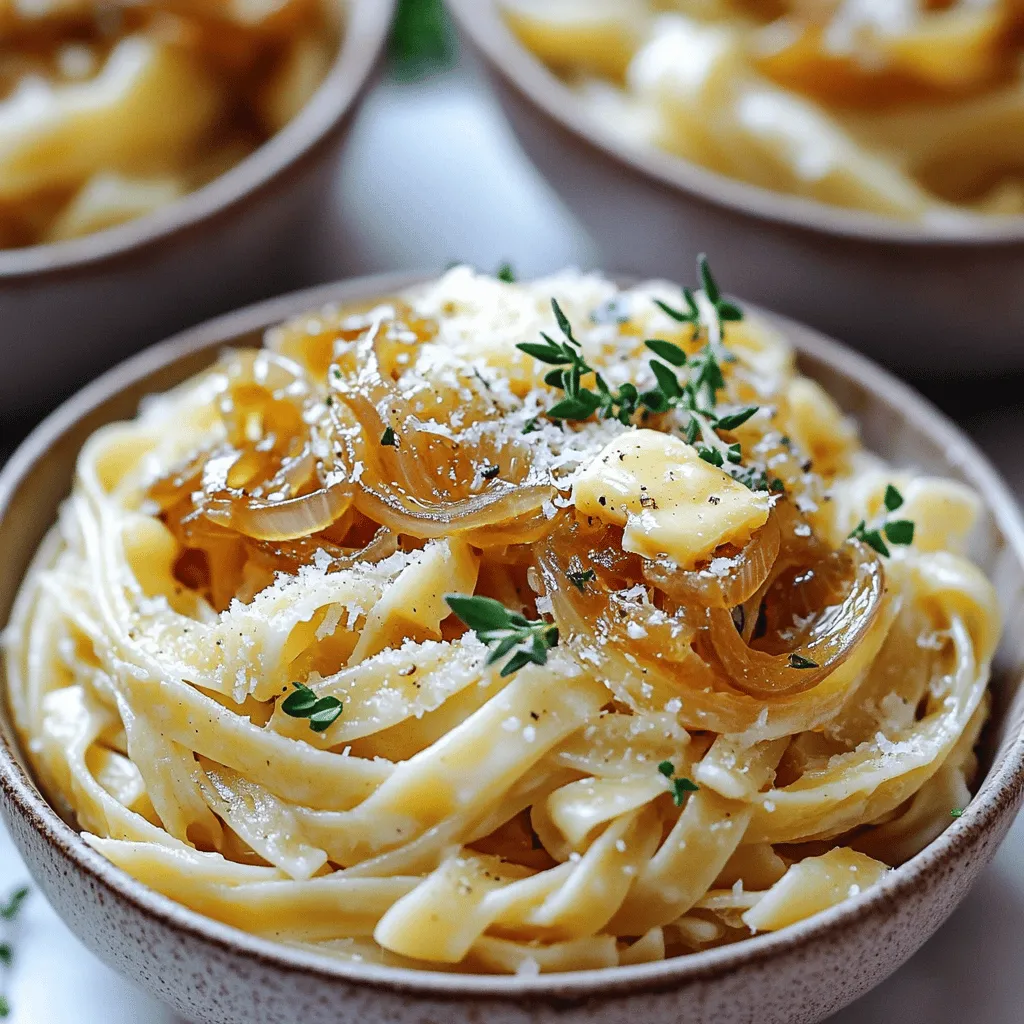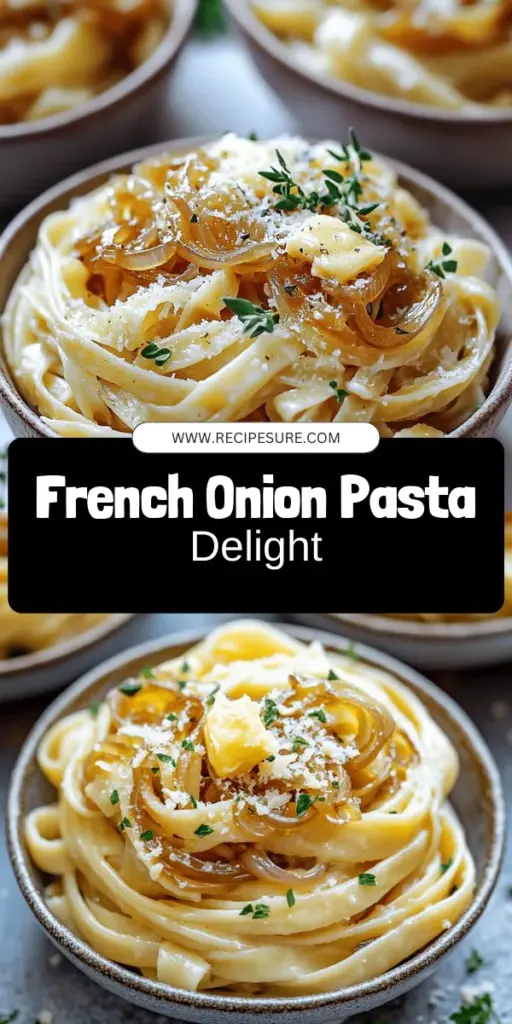Introduction
French Onion & Browned Butter Pasta is a delightful dish that brings together the rich, savory flavors of classic French onion soup and the comforting heartiness of pasta. Imagine al dente strands coated in a buttery, savory sauce that highlights the deep caramelization of onions and the nutty undertones of browned butter. This recipe is a celebration of culinary fusion, where two beloved comfort foods meet to create a satisfying meal that is simple yet impressive.
The magic of this dish lies in its layers of flavor. Caramelized onions, with their sweet, rich taste, meld beautifully with the nutty, toasty notes of browned butter, resulting in a pasta dish that is both comforting and sophisticated. This combination not only elevates your typical pasta experience but also invites a sense of warmth and nostalgia reminiscent of a cozy French bistro. To achieve the best results, it’s crucial to focus on quality ingredients, as they play a pivotal role in maximizing the flavor and overall experience of the dish.
The Allure of French Onion Pasta
The origins of French onion soup trace back to ancient times, but it was in the 18th century that it became a staple in French cuisine. Traditionally, the soup is made with caramelized onions, beef broth, and topped with melted cheese, creating a dish that is warming and deeply satisfying. In this recipe, we take inspiration from this classic and transform it into a pasta dish that retains the essence of its roots while providing a new and exciting twist.
Caramelized onions are the star of this dish, offering a sweet and savory profile that is hard to resist. The slow cooking process transforms their sharpness into a mellow sweetness, enhancing their natural flavors. When incorporated into pasta, these beautifully caramelized onions create a rich sauce that clings to every strand, ensuring that each bite is packed with flavor.
Adding to the depth of flavor is the process of browning butter. This technique involves cooking butter until its milk solids turn golden brown, releasing a nutty aroma and flavor that elevates any dish. The combination of browned butter and caramelized onions creates a luxurious sauce that envelops the pasta, making this dish a true indulgence.
Ingredients Breakdown
Before diving into the cooking process, let’s take a closer look at the essential ingredients that will bring our French Onion & Browned Butter Pasta to life.
Pasta Choice: Fettuccine or Tagliatelle
When it comes to pasta, the choice between fettuccine and tagliatelle can influence the texture and overall experience of the dish. Both types are long, flat noodles that are perfect for holding onto rich sauces. Fettuccine, originating from Italy, is slightly wider and has a chewy texture, while tagliatelle is narrower and more delicate. Either option will work beautifully in this recipe, so choose based on your preference or what you have on hand.
Onions: Types and Tips for Selection
The type of onion you use can significantly affect the flavor profile of the dish. While yellow onions are the traditional choice for French onion soup due to their balance of sweetness and sharpness, you can also experiment with sweet onions like Vidalia for an even sweeter sauce. When selecting onions, look for firm bulbs with no soft spots or blemishes. The more evenly shaped the onion, the better it will caramelize.
Butter and Olive Oil: Importance of Fat in Flavor Development
The fats used in this recipe play a crucial role in flavor development. We’ll be using both butter and a splash of olive oil. Butter is essential for its rich flavor and ability to brown, while olive oil helps prevent the butter from burning during the cooking process. This combination allows for a smooth, velvety sauce that enhances the overall dish.
Sugar: Role in Caramelization
To aid in the caramelization process of the onions, a small amount of sugar is added. While onions naturally contain sugars that caramelize as they cook, adding a pinch can help accelerate this process, resulting in beautifully browned onions more quickly. This step is especially helpful if you’re short on time but still want that deep flavor.
Garlic and Thyme: Aromatics That Elevate the Dish
Garlic and fresh thyme are used to enhance the overall flavor of the pasta. Garlic adds a pungent, aromatic quality that complements the sweetness of the onions, while thyme brings an earthy, herbal note that rounds out the dish beautifully. Fresh herbs are always recommended for their vibrant flavor, but dried thyme can be used in a pinch.
Broth: Choosing Between Beef and Vegetable for Flavor Depth
The choice of broth can greatly influence the flavor depth of your pasta sauce. For a more traditional approach, beef broth is preferred because of its rich, hearty flavor. However, if you are looking for a lighter or vegetarian option, vegetable broth works well too. Be sure to choose a high-quality broth for the best results, as this will form the base of your sauce.
Parmesan Cheese: Types and How to Choose the Best Quality
No pasta dish is complete without a generous sprinkle of cheese, and for this recipe, Parmesan is the perfect choice. Aged Parmesan adds a salty, nutty flavor that complements the sweetness of the onions. When selecting Parmesan, look for a block of cheese that you can grate fresh. Pre-grated varieties often lack flavor and texture, so investing in a good quality cheese will enhance your dish.
Seasoning: The Balance of Salt and Pepper
Finally, don’t forget about seasoning! A balanced dish requires the right amount of salt and freshly cracked black pepper. The salt enhances the natural flavors of the ingredients, while pepper adds a subtle heat. Taste as you go to ensure that the seasoning is just right.
Step-by-Step Instructions
Now that we have gathered all our ingredients, let’s move on to the cooking process. This recipe involves two main steps: cooking the pasta and caramelizing the onions.
Cooking the Pasta
1. Prepare the Pot: Fill a large pot with water and bring it to a rolling boil. It’s essential to use plenty of water to allow the pasta to cook evenly and prevent it from sticking together.
2. Salt the Water: Once boiling, add a generous amount of salt to the water. A good rule of thumb is to aim for a saltiness similar to the ocean. This step is crucial as it flavors the pasta itself, ensuring that every bite is seasoned properly.
3. Cook the Pasta: Add your fettuccine or tagliatelle to the boiling water. Stir gently to prevent sticking. Follow the package instructions for cooking time, but aim to cook the pasta al dente. This means it should be cooked through but still have a slight bite to it.
4. Reserve Pasta Water: Before draining the pasta, reserve about a cup of the starchy cooking water. This water can be added to the sauce later to help achieve the perfect consistency.
Caramelizing the Onions
1. Heat the Pan: In a large skillet, heat a combination of butter and olive oil over medium heat. The fat should be hot but not smoking.
2. Add the Onions: Once the butter has melted, add the sliced onions to the pan. Stir them to coat with the fat and allow them to cook down.
3. Season and Sugar: Sprinkle a pinch of salt and a teaspoon of sugar over the onions. The salt helps draw out moisture, while the sugar aids in the caramelization process.
4. Low and Slow: Reduce the heat to medium-low and let the onions cook slowly. Stir them occasionally to prevent burning, allowing them to develop a deep golden color. This process typically takes about 20-30 minutes, depending on the heat and the amount of onions used.
5. The Science Behind Caramelization: As the onions cook, they will lose moisture and their natural sugars will caramelize. The Maillard reaction occurs, creating complex flavors and a wonderful aroma. Be patient, as this step is crucial for achieving the perfect depth of flavor.
As you caramelize the onions, you will notice the transformation from pungent and sharp to sweet and savory. The aromas filling your kitchen will be irresistible and set the stage for the delicious pasta dish to come.
—
Following these steps will lay a solid foundation for the preparation of your French Onion & Browned Butter Pasta. In the next part of the article, we will explore how to bring all the components together and finalize this delightful dish. Stay tuned for the continuation of this savory journey!

Adding Flavor: Garlic and Thyme
To elevate the flavor profile of your French Onion & Browned Butter Pasta, the addition of garlic and fresh thyme is essential. Garlic brings a robust warmth, while thyme adds an earthy aroma that complements the sweetness of the caramelized onions perfectly.
Timing and Technique for Adding Aromatics
When your onions have reached a beautiful golden brown, it’s time to introduce the aromatics. Add minced garlic to the pan about 1-2 minutes before the onions are fully caramelized. This timing ensures the garlic becomes fragrant without burning, which can lead to a bitter taste. Stir gently and keep an eye on it, as garlic can easily go from perfectly golden to burnt in mere seconds.
Next, sprinkle in fresh thyme leaves. If you’re using dried thyme, reduce the amount by half, as dried herbs are more concentrated in flavor. Let the garlic and thyme mingle with the onions for just a minute, releasing their essential oils and adding further depth to your dish.
Incorporating Broth
Now, let’s talk about broth. Incorporating broth into your pasta dish not only enhances moisture but also adds layers of flavor.
How Broth Adds Moisture and Depth
Once your aromatics are ready, deglaze the pan with a splash of vegetable or chicken broth. This technique lifts the flavorful bits stuck to the bottom of the pan, infusing your pasta with a rich taste. The broth should simmer and reduce slightly, concentrating its flavors while ensuring your pasta will be perfectly moist.
The Art of Browning Butter
Browning butter is a revered technique in French cuisine, adding nutty richness to your dish.
Step-by-Step on Achieving the Perfect Browned Butter
1. Begin with unsalted butter in a light-colored skillet. This allows you to monitor the color change as it cooks.
2. Melt the butter over medium heat until it starts to foam.
3. Keep stirring gently with a wooden spoon, checking the color frequently. The butter will first become bubbly, then clarify, and finally turn a golden brown with a nutty aroma.
4. Once it reaches the desired golden color (similar to that of a penny), immediately remove it from the heat to prevent burning.
Tips for Avoiding Burnt Butter
- Use a light-colored pan to see the butter’s progression clearly.
- Stir continuously to prevent the milk solids from settling and burning.
- If you’re unsure, err on the side of caution and remove the butter while it’s still a little lighter than you’d like; it will continue to cook slightly once removed from the heat.
Combining Ingredients
With all components ready, it’s time to bring your dish together.
Best Practices for Mixing Pasta and Sauce
1. Cook your pasta in salted boiling water until al dente, reserving about a cup of pasta water before draining.
2. In the skillet with your caramelized onions, garlic, and thyme, add the drained pasta directly.
3. Gradually pour in the browned butter and broth mixture, tossing gently to coat the pasta evenly.
4. If the mixture looks too dry, add reserved pasta water a little at a time until you reach your desired creaminess.
Importance of Pasta Water in Achieving Creaminess
Pasta water is rich in starch, which helps bind the sauce to the pasta, creating a silky texture. This is a chef’s secret weapon for achieving that restaurant-quality finish.
Presentation Techniques
Creating an inviting plate is just as important as the flavors. Here are some ideas for serving and plating your French Onion & Browned Butter Pasta.
- Twist and Twirl: Use a fork to twist a portion of pasta into a nest shape on the plate for an elegant presentation.
- Layering: Add a layer of pasta, followed by a drizzle of the browned butter sauce, and then another layer of pasta.
- Garnishing: Sprinkle freshly chopped parsley over the top for a pop of color and freshness.
Importance of Garnishing with Parsley and Cheese
Finish your dish with a generous grating of Parmigiano-Reggiano or Gruyère cheese. The salty, nutty flavors enhance the richness of the pasta. A sprinkle of fresh parsley not only adds color but also a burst of fresh flavor that lifts the entire dish.
Nutritional Information
This pasta dish, while indulgent, offers a blend of nutritional benefits thanks to its wholesome ingredients.
Overview of the Nutritional Benefits of the Ingredients
- Onions: Packed with antioxidants and vitamin C, onions also support heart health.
- Garlic: Known for its immune-boosting properties, garlic may help reduce blood pressure and improve cholesterol levels.
- Thyme: This herb is high in vitamins A and C and contains antimicrobial properties.
- Pasta: Opting for whole grain or legume-based pasta increases fiber and protein content.
Balancing Indulgence with Nutrition
While this dish is rich and comforting, incorporating more vegetables—such as spinach or mushrooms—can enhance its nutritional profile without sacrificing flavor.
Variations and Adaptations
The beauty of this recipe lies in its flexibility. Here are some suggestions to accommodate various dietary preferences.
Suggestions for Vegetarian or Vegan Adaptations
- Substitute butter with olive oil or vegan butter for a dairy-free option.
- Use vegetable broth instead of chicken broth to keep it plant-based.
- Incorporate additional vegetables like bell peppers or zucchini to enhance the dish’s heartiness.
Ideas for Adding Protein (e.g., Chicken, Shrimp)
For those who prefer a protein boost, grilled chicken or sautéed shrimp can elevate this dish. Simply cook the protein separately and toss it in with the pasta just before serving for a complete meal.
Options for Gluten-Free Pasta
For a gluten-free version, opt for gluten-free pasta made from brown rice, quinoa, or chickpeas. The cooking process remains the same, ensuring everyone can enjoy this delicious dish.
Cultural Significance of French Cuisine
French onion soup has a storied history, originating as a simple peasant dish that eventually gained fame in fine dining due to its rich, complex flavors.
Brief History of French Onion Soup and Its Culinary Importance
Traditionally made with caramelized onions, beef broth, and topped with cheese and croutons, this dish represents the heart of French culinary techniques—slow cooking and flavor development.
How This Dish Represents the Fusion of French Cooking Techniques and Italian Pasta Tradition
The French Onion & Browned Butter Pasta exemplifies the beautiful fusion of French and Italian cuisines. By combining the classic French soup flavors with Italian pasta, this dish embodies the creativity and versatility that both cuisines celebrate.
Conclusion
The French Onion & Browned Butter Pasta is not just a meal; it’s an experience—a perfect harmony of flavors that transports your taste buds to the heart of French and Italian culinary traditions. Its unique qualities, from the rich caramelized onions to the nutty browned butter, ensure that each bite is a delight.
We encourage you to try this recipe, explore new flavor combinations, and share the joy of cooking with family and friends. There’s something special about gathering around the table, enjoying a home-cooked meal that nourishes not just the body, but the soul as well. So gather your ingredients, roll up your sleeves, and let the delightful aromas fill your kitchen!


